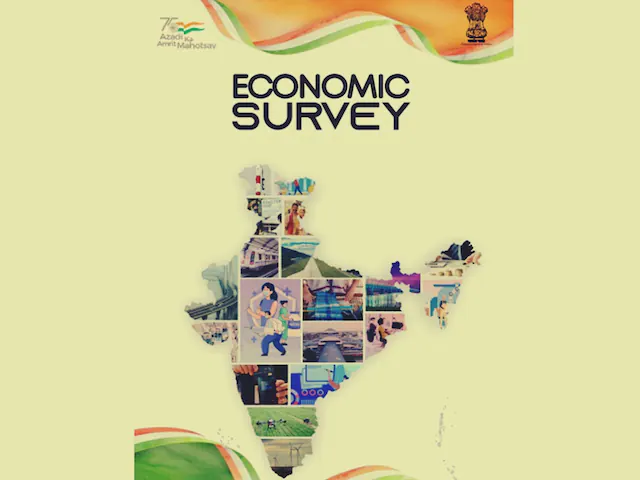Context:
According to the Economic Survey 2023-24 presented by the Finance Minister in Parliament, the Indian economy remains robust and stable, showing resilience despite geopolitical challenges
Overview of the 2023 Economic Survey
State of the Indian Economy
- Global economic growth was 3.2 percent in 2023, as reported in the April World Economic Outlook.
- Diverging growth patterns among countries were influenced by domestic structural issues, geopolitical conflicts, and monetary policy tightening.
- Despite external challenges, India’s economy maintained momentum from FY23 into FY24, with real GDP growing by 8.2% and exceeding 8 % in three of four quarters of FY24.
- The government’s focus on macroeconomic stability minimized the impact of external challenges.
- Increased capital expenditure and private investment boosted capital formation growth, with Gross Fixed Capital Formation rising by 9% in real terms in 2023-24.
- Healthier corporate and bank balance sheets are expected to further strengthen private investment, and positive trends in the residential real estate market indicate significant household sector capital formation.
- The urban employment rate declined to 7.2% in Q2 FY23.
Fiscal Deficit
- The fiscal deficit decreased to 6.7% in FY22 from 9.2% in FY21 due to the pandemic. Gross tax revenue grew by 15.5% year-on-year from April to November 2022.
- GST collections rose by 24.8% from April to December 2022.
- The government earned ₹4.07 lakh crore through strategic disinvestment, and government debt moderated from 59.2% in FY21 to 56.7% in FY22.
Monetary Policy
- Globally, tighter monetary policies were adopted due to inflation. While global capital markets underperformed, Indian markets fared well.
- The Reserve Bank of India increased the repo rate from 4% to 6.25% between May and December 2022, leading to higher deposit and lending rates.
- The trading volume of government securities reached a two-year high with 6.3% year-on-year growth.
- This period also saw the initial public offering of state-run insurer LIC, India’s largest IPO.
Inflation
- Inflationary pressures from global issues, supply chain disruptions, and monsoon variability were effectively managed by administrative and monetary policy responses.
- Consequently, retail inflation declined from an average of 6.7 % in FY23 to 5.4 percent in FY24.
- Domestic inflation reached 7.8%, mainly due to rising food prices, especially in rural areas.
Social Infrastructure
- The survey reported steady increases in social expenditure, with healthcare sector spending moving towards 2.5% of GDP, as recommended by the National Health Policy.
- According to the survey, 16.4% of the population was classified as multi-dimensionally poor.
External Sector
- India’s external sector remained strong despite geopolitical headwinds and persistent inflation.
- Logistics Performance Index: India improved its rank from 44th in 2018 to 38th in 2023 out of 139 countries.
- Export Diversification: India is adding more export destinations, indicating regional diversification.
- Current Account Deficit: Narrowed to 0.7% in FY24 due to moderation in merchandise imports and rising services exports.
- Services Exports: Grew by 4.9% to USD 341.1 billion in FY24. Growth was driven by IT/software services and ‘other’ business services.
- Remittances: India is the top remittance recipient globally, reaching USD 120 billion in 2023.
- External Debt: Sustainable with an external debt to GDP ratio of 18.7% at the end of March 2024.
- Challenges: Slowing global GDP growth and rising trade protectionism pose significant risks.
What is the Economic Survey?
- The Economic Survey is a comprehensive annual review of the Indian economy for the previous financial year.
- It is prepared by the Economics Division of the Department of Economic Affairs under the Finance Ministry, guided by the Chief Economic Advisor (CEA).
- It is released a day ahead of the Budget announcement.
- It summarizes the government’s economic performance, major developmental programs, and policy initiatives, while also providing an outlook for the upcoming financial year.
Significance of the Economic Survey
- The Economic Survey reviews India’s development over the past financial year, providing statistical data on industry, agriculture, employment, prices, and exports.
- It highlights priority areas for the next financial year ahead of the Budget, though its recommendations are not binding.
- Serving as a stock-taking document, it informs citizens about the economy and key government decisions.
- The Survey consolidates annual reports from various ministries, departments, and regulators into a single authoritative document.
Presentation of the Economic Survey
- Typically, the Economic Survey is presented on January 31. However, this year it was delayed due to the general elections.
- According to the Parliamentary convention, the incumbent government does not present the Economic Survey with the Interim Budget in an election year.
- Therefore, the Survey was rescheduled for July to align with the full Budget presentation post-elections.
Also Read:
Small Animals ‘bdelloid rotifers acquire Antibiotic-Producing Genes from Bacteria

